Edge suction device
1. The function and type of edge suction device
The edge suction device is a component of the open-width fabric guide. It is installed in front of the cloth inlet of each open-width machine. Its function is to ensure that the open-width fabric follows the regulations. Position operation to prevent the fabric from deflecting left and right, and at the same time play a certain role in expanding and preventing wrinkles on the fabric.
Based on its working principle, edge suction devices can be divided into two categories: pressure relief type and swing type. Most edge suction devices currently widely used are of the pressure relief type. This type of edge suction device can be divided into heavy hammer type, electric type and pneumatic type according to its pressure relief mechanism; according to its operating mechanism, it can also be divided into contact rod type, friction wheel type and fully electric type. Since the heavy hammer type edge suction device has a complicated mechanism and is inconvenient to operate, it is rarely used now.
2. The structure of the edge suction device
1. Pneumatic edge suction device
The pneumatic edge suction device consists of three parts: the machine head, the bracket and the compressed air source, as shown in Figure 2-13.
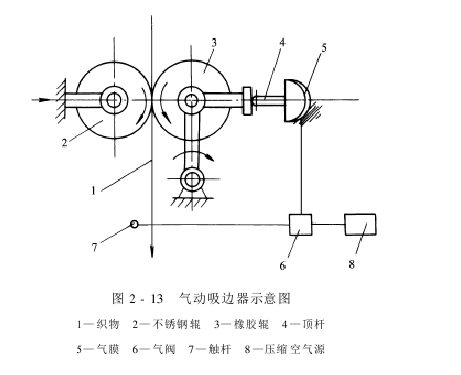
Head It is the main functional component, one on each side. Each machine head is composed of a pair of small rollers (one soft and one hard), ejector pin, air film, air valve, contact rod, etc. The machine head is installed on the bracket and can rotate at a certain angle. Generally, the axis of the small pressure roller and the weft direction of the fabric are at an angle of 10° to 20°. When the fabric is running normally, the air valve is opened, and the compressed air passes through the air film and the ejector rod to press the small rollers on the two machine heads evenly on the fabric, producing equal edge suction forces. If the fabric deviates to the left to a certain extent, the edge touches the touch rod, causing the air valve of the left machine head to close, and the air pressure on the air film is released, causing the rubber roller to fall backwards under its own weight, and the left side of the fabric that was originally pressed is closed. The pair of small rollers on the side are detached, the suction force on the left side disappears, and the fabric moves back to the right to the middle position. Otherwise, move to the left. In this way, the excessive left and right deviation of the fabric during operation is corrected, so that the fabric moves within the agreed normal range.
In addition to using compressed air, the pneumatic edge suction device does not require other power sources and is suitable for humid production environments, especially where fire protection and explosion protection are required. The pneumatic edge suction device has small operating force and is adjustable. The pressure between the two rollers is large and can be adjusted as required. It has sensitive action, wide application range, no electrical contacts, is safe and reliable, and is easy to install.
2. Electric edge suction device
Figure 2-14 shows an electric edge suction device that is currently widely used in China. Its pair of pressure rollers consists of a stainless steel roller and a rubber roller. The stainless steel roller is equipped with a fixed electromagnetic magnet and a movable armature. A spring is installed between the suction iron and the armature, the fixed suction iron is installed on the bracket, and the movable armature is connected to the stainless steel roller body. When the fabric is running normally, the space between the two rollers is pressurized by the suction spring, and the suction forces on both sides of the open-width fabric are equal. When the fabric is deflected, it touches the contact rod, and the operating element is used to make the suction iron work, overcome the spring pressure, release the pair of pressure rollers and release the pressure, and the fabric moves back to the other side, thereby correcting the deflection.
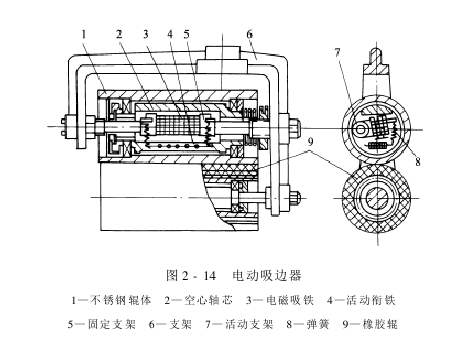
Electric vacuum cleaner The edger has a compact structure, sensitive movement, large pressure between the two rollers, and good deflection correction and spreading effects. It is very suitable for dry environments and occasions with high speed requirements. However, due to the poor sealing of the stainless steel roller, the movement of the iron attraction is controlled by the contact rod and electrical contacts, which requires high maintenance.
3. Working principle of edge suction device
The generation of edge suction force is closely related to the physical state of the fabric. Since the fabric is a flexible body, when the objectively existing warp tension reaches a certain level, a force Ta will be generated from the left and right sides pointing toward the middle, causing the fabric to shrink in the weft direction. This is Weft tension. If the fabric comes into contact with a passive cloth guide roller at this time, the passive cloth guide roller will rotate under the reaction force f’ of the meridional friction force f. At the same time, the existence of axial friction resistance on the roller surface will block the weft shrinkage of the fabric.
In order to facilitate the analysis, the interaction force between the warp and weft yarns of the fabric is ignored. It is assumed that the weft expansion force is larger than the warp tension, so that only the warp yarns bend during the expansion process of the fabric, and the fabric leaves the small pressure roller nip point. The elastic shrinkage after.
As shown in Figure 2-15, the inclination angle of the two small pressure rollers of the edge suction device is α, the effective length of the pressure roller extending the fabric is l0, and the fabric runs from top to bottom .
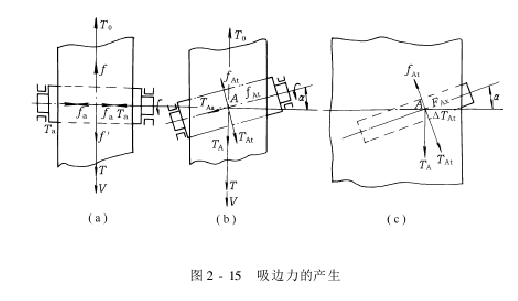
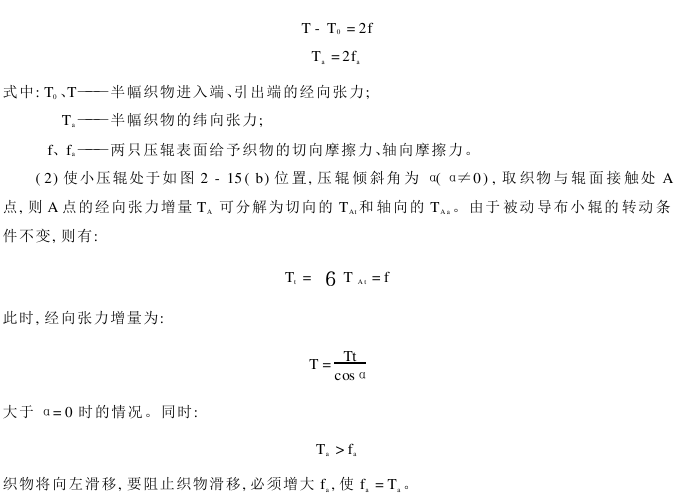
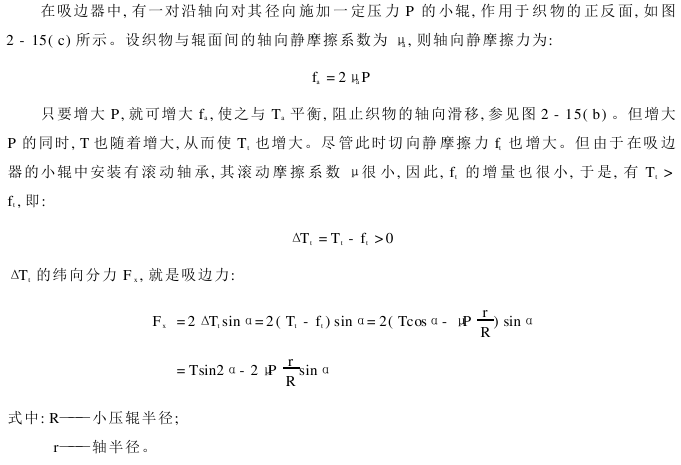
(1) Put the small pressure roller in the position shown in Figure 2-15(a), α=0, analyze this Force balance relationship of half fabric:
It can be seen that, ignoring the second term in the above formula, when α=45°, Fx is large. In fact, due to the existence of the second term and considering the error caused by the idealization in the above discussion, when α<45°, Fx has reached a large value.
From the above analysis, the following conclusions can be drawn:
① The edge suction force Fx increases with the increase of the angle α, but there is a limit value and cannot be increased arbitrarily . Taking into account that excessive edge suction force will cause greater damage to the fabric.The slope is generally 10°≤α≤20°.
② To balance Ta, a sufficiently large axial static friction force fa must be provided, so P must be large enough. Otherwise, it will not only affect the edge suction, but may even wrinkle or escape. However, P cannot be too large. Because, if P is too large, it will not only produce indentations on the fabric, but may also affect the fastness of the fabric fiber. Therefore, when installing the edge suction device, the pressure P between the small rollers must be carefully adjusted according to the type of fabric and α angle.
③The roller surface and fabric must not slip. Because when slipping, the nature of friction changes from static friction to sliding friction, causing fa to decrease sharply, destroying the relationship between fa and Ta Balanced, the edge extractor doesn’t work properly or even at all.
④ Reduce bearing friction and facilitate edge suction. For this reason, it is necessary to strengthen the maintenance of the rotating parts of the small roller of the edge suction device and maintain good lubrication.
4. Installation, use and maintenance of the edge suction device
(1) The stainless steel roller of the electric edge suction device has poor sealing and poor adaptability to environments with high temperature, high humidity and severe corrosion. Therefore, regular maintenance is important. It is generally best to do cleaning and inspection work once every 1 to 2 weeks.
(2) After the electrical contacts are used for a certain period of time, the surface will become rough, which will reduce the sensitivity of the edge collector. It can be polished with fine sandpaper to make the surface smooth so that it can work normally.
(3) The transformer of the side suction device is designed according to the single-side head action. Therefore, there should be certain barriers between the machine heads on both sides, so that the edge of the fabric and the contact rod are 10 to 20mm apart to avoid damage to the transformer caused by the machine heads on both sides working at the same time. Moreover, it can also avoid the frequent iron suction movements that greatly shorten the service life of the edge suction device. But if the distance is too large, the fabric will easily shift and cause de-clipping.
(4) Check whether the roller surface is clean and flat to prevent fabric scratches and scratches.
(5) The bearings should be refueled regularly, and the yarn ends, dust and oil at the end of the pressure roller should be cleaned to prevent the pressure roller from rotating insensitively and causing oil stains on the fabric.
(6) The installation angle of the edge suction roller is related to the speed, thickness, width and dry humidity of the fabric. Generally, the axis of the small roller and the weft direction of the fabric are preferably 10° to 20°.
(7) The fabric must pass through the pressure points of the two pressure rollers from the tangential direction, and it must be in a straight line when entering and exiting.
(8) The height of the center of the amplitude modulating beam of the edge suction device from the ground is about 1.5m, the height of the cloth inlet roller from the ground is 2~3m, and the height of the cloth outlet roller from the ground is about 0.5m.
(9) Regularly check whether gas storage barrels, pipelines, etc. are leaking, and whether pressure gauges, air films, and air valves are damaged.
AAAFGBHGYUTKU



